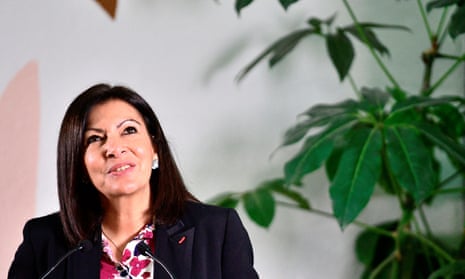The Paris mayor, Anne Hidalgo, has made phasing out vehicles and creating a “15-minute city” a key pillar of her offering at the launch of her re-election campaign.
The Socialist politician wants to encourage more self-sufficient communities within each arrondissement of the French capital, with grocery shops, parks, cafes, sports facilities, health centres, schools and even workplaces just a walk or bike ride away.
Called the “ville du quart d’heure” – the quarter-hour city – the aim is to offer Parisians what they need on or near their doorstep to ensure an “ecological transformation” of the capital into a collection of neighbourhoods. This, she said, would reduce pollution and stress, creating socially and economically mixed districts to improve overall quality of life for residents and visitors.
“Paris is a city unlike any other … it is independent, lively, vibrant. It is capable of inventing a new history without forgetting its past,” Hidalgo said at Thursday’s launch.
The driving force behind the 15-minute city idea is the Sorbonne professor Carlos Moreno, who believes the “core of human activity” in cities must move away from oil-era priorities of roads and car ownership as we move into a post-vehicle era.
“We need to reinvent the idea of urban proximity,” Moreno says. “We know it is better for people to work near to where they live, and if they can go shopping nearby and have the leisure and services they need around them too, it allows them to have a more tranquil existence.
“Work is more problematic because people’s jobs are often some way from their homes, but we must rethink this too. Today, our approach to work is the same as it has been for the last 50 years. Is it always necessary to show up somewhere, to be physically present in front of the boss? It is possible to do things differently.”
Moreno, a Franco-Colombian who has lived in Paris since he was 20, is delighted Hidalgo has personally picked up his concept of what he calls a “living smart city” and put it at the heart of her political campaign.
“When she called me and said she was interested and we met, I thought it would be a paragraph down the bottom of the campaign leaflet, but it’s there at the centre,” he told the Guardian.

The living smart city is more dense but people friendly, Moreno says, painting the picture of an urban utopia where people know each other and “say bonjour” rather than rushing from one place to another in “a permanent state of anxiety”. The approach is based on four major principles: proximity, diversity, density and ubiquity, and individual areas within the city should be able to fulfil six social functions: living, working, supplying, caring, learning and enjoying.
“Living differently means above all transforming our relationship with time, especially time relating to moving around. Commuting is costly in every respect,” Moreno says.
“There is no pleasure, no comfort in it. Take the metro or the suburban train and you see people who are in a state of stress and anguish. That is why we have to have this revolution, to have a city with lots of centres where people can find what they need. We need to break this rhythm of people’s lives, it is a radical approach that will transform lifestyles.”
The 15-minute city is not a new idea, but would mark a revolutionary step in a city the size of Paris, the centre of which, bounded by the périphérique ring road, is home to more than 2.2 million people.
Melbourne has developed 20-minute neighbourhoods where everything – shops, schools, parks, doctors – is within a 20-minute walk, a bike ride or on public transport. Moreno also cites Copenhagen in Denmark and Utrecht in the Netherlands as cities that have successfully introduced the idea of “hyper proximity” to fulfil the needs of city dwellers.
In an hour-long speech unveiling an ambitious plan for the city, Hidalgo promised a sweeping range of policies covering every aspect of city life – from a new 5,000-strong unarmed municipal police force to free sanitary products in schools and public offices, via massive tree-planting and increased fines for “uncivil” behaviour such as urinating in the street or throwing cigarettes on the ground. She said the policies would be examined for their ecological and environmental impact.
To the dismay of the car lobby, already angered by the closure of the highways either side of the River Seine that runs through the centre of Paris, Hidalgo has promised to continue pedestrianising swathes of the capital, plus a €350m (£300m) plan to create “a bike lane in every street” by 2024, and a plan to do away with 60,000 parking spaces for private cars.

Main roads through Paris will be inaccessible to motor vehicles, “children streets” will be created next to schools for term time, and the schools turned over to local residents during weekends and holidays.
Moreno says he was inspired by the American-Canadian author and activist Jane Jacobs, author of the 1961 classic The Death and Life of Great American Cities.
“A neighbourhood, she wrote, is not only an association of buildings but also a network of social relationships, an environment where the feelings and the sympathy can flourish.”
Hidalgo, who introduced the “participatory budget”, allowing residents to propose ideas and vote for what 5% of the city’s investment budget would be spent on every year, said she would increase this to 25%.
“My project is about proximity, participation, collaboration and ecology. In Paris we all feel we have no time, we are always rushing to one place or another, always trying to gain time. That is why I am convinced we need to transform the city so Parisians can learn, do sports, have healthcare, shop, within 15 minutes of their home.
“This will take Paris into the future.”
